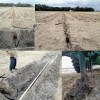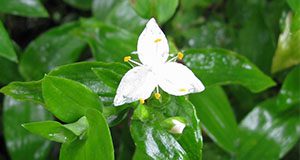Tradescantia fluminensis (small-leaf spiderwort) is a perennial subsucculent herb native to tropical and subtropical regions of Brazil and Argentina. The species has been introduced to the United States and countries in many parts of the world where it is often considered invasive. This seven-page fact sheet describes the small-leaf spiderwort, its taxonomy, geographical distribution, biology and ecology, reproduction and colonization, its impact as a weed in the southeastern United States, and ways of managing the spread of small-leaf spiderwort. Written by Jason C. Setiz and Mark W. Clark and published by the Department of Soil and Water Science.
http://edis.ifas.ufl.edu/ss652
Tag: Mark W. Clark
Subsurface Drip Irrigation (SDI) for Enhanced Water Distribution: SDI – Seepage Hybrid System (HS1217)
 In terms of water use efficiency, the traditional seepage irrigation systems commonly used in areas with high water tables are one of the most inefficient methods of irrigation, though some irrigation management practices can contribute to better soil moisture uniformity. Subsurface drip irrigation systems apply water below the soil surface by microirrigation, improving the water distribution and time required to raise the water table for seepage irrigation. This 6-page fact sheet was written by Lincoln Zotarelli, Libby Rens, Charles Barrett, Daniel J. Cantliffe, Michael D. Dukes, Mark Clark, and Steven Lands, and published by the UF Department of Horticultural Sciences, March 2013.
In terms of water use efficiency, the traditional seepage irrigation systems commonly used in areas with high water tables are one of the most inefficient methods of irrigation, though some irrigation management practices can contribute to better soil moisture uniformity. Subsurface drip irrigation systems apply water below the soil surface by microirrigation, improving the water distribution and time required to raise the water table for seepage irrigation. This 6-page fact sheet was written by Lincoln Zotarelli, Libby Rens, Charles Barrett, Daniel J. Cantliffe, Michael D. Dukes, Mark Clark, and Steven Lands, and published by the UF Department of Horticultural Sciences, March 2013.
http://edis.ifas.ufl.edu/hs1217
Small-Scale Natural Wastewater Treatment Systems: Principles and Regulatory Framework (SL365/SS566)
 Natural systems use the natural processes of wetland ecosystems to both transform and hold on to many of the common pollutants that occur in household wastewater. This 8-page fact sheet briefly describes the principles and added benefits of natural systems. It then focuses on their use for treating small municipal wastewater flows from commercial and residential sites (i.e., septic systems or decentralized wastewater systems). Written by Kiara Winans, Shanin Speas-Frost, Mike Jerauld, Mark Clark, and Gurpal Toor, and published by the UF Department of Soil and Water Science, May 2012.
Natural systems use the natural processes of wetland ecosystems to both transform and hold on to many of the common pollutants that occur in household wastewater. This 8-page fact sheet briefly describes the principles and added benefits of natural systems. It then focuses on their use for treating small municipal wastewater flows from commercial and residential sites (i.e., septic systems or decentralized wastewater systems). Written by Kiara Winans, Shanin Speas-Frost, Mike Jerauld, Mark Clark, and Gurpal Toor, and published by the UF Department of Soil and Water Science, May 2012.
http://edis.ifas.ufl.edu/ss566
Accounting for the Nutrients in Reclaimed Water for Landscape Irrigation (AE479)
 This 8-page fact sheet presents basic information for those using reclaimed water to irrigate lawns and landscapes. The information can serve as a guide to determine whether there is an opportunity to replace some of the fertilizer that might otherwise be applied and to offer guidance on avoiding runoff and leaching of excess nutrients. Written by Christopher J. Martinez, Mark W. Clark, Gurpal S. Toor, George J. Hochmuth, and Lawrence R. Parsons, and published by the UF Department of Agricultural and Biological Engineering, August 2011. (UF/IFAS photo by Marisol Amador)
This 8-page fact sheet presents basic information for those using reclaimed water to irrigate lawns and landscapes. The information can serve as a guide to determine whether there is an opportunity to replace some of the fertilizer that might otherwise be applied and to offer guidance on avoiding runoff and leaching of excess nutrients. Written by Christopher J. Martinez, Mark W. Clark, Gurpal S. Toor, George J. Hochmuth, and Lawrence R. Parsons, and published by the UF Department of Agricultural and Biological Engineering, August 2011. (UF/IFAS photo by Marisol Amador)
http://edis.ifas.ufl.edu/ae479
A Guide to EPA’s Numeric Nutrient Water Quality Criteria for Florida (SL316/SS528)
This revised 10-page guide provides a basic, concise, and understandable description of the United States Environmental Protection Agency’s (EPA) numeric nutrient criteria for Florida, the background events that led to its release, some pertinent scientific issues, and implications for the future. Written by Thomas Obreza, Mark Clark, Brian Boman, Tatiana Borisova, Matt Cohen, Michael Dukes, Tom Frazer, Ed Hanlon, Karl Havens, Chris Martinez, Kati Migliaccio, Sanjay Shukla, and Alan Wright, and published by the UF Department of Soil and Water Science, March 2011.
http://edis.ifas.ufl.edu/ss528
SL316/SS528 A Guide to EPA’s Proposed Numeric Nutrient Water Quality Criteria for Florida
SL316, a 9-page illustrated guide by Thomas Obreza, Mark Clark, Brian Boman, Tatiana Borisova, Matt Cohen, Michael Dukes, Tom Frazer, Ed Hanlon, Karl Havens, Chris Martinez, Kati Migliaccio, Sanjay Shukla, and Alan Wright, provides a basic, concise, and understandable description of the United States Environmental Protection Agency’s (EPA) proposed numeric nutrient criteria for Florida, the background events that led to its release, some pertinent scientific issues, and implications for the future. Published by the UF Department of Soil and Water Science, February 2010.
http://edis.ifas.ufl.edu/ss528
SL307/SS519 Wetlands in Your County: Alachua
SL307, a 5-page illustrated fact sheet by Mark W. Clark, Stacie Greco and Susan Curry, provides specific information about wetlands in Alachua County. Published by the UF Department of Soil and Water Sciences, December 2009.
http://edis.ifas.ufl.edu/SS519
AE449 Using Reclaimed Water for Landscape Irrigation
AE449, a 6-page fact sheet by Christopher J. Martinez and Mark W. Clark, discusses how to manage for salinity and nutrients contained in reclaimed water when using it for landscape irrigation. Includes references. Published by the UF Department of Agricultural and Biological Engineering, July 2009.
http://edis.ifas.ufl.edu/AE449
AE448 Reclaimed Water and Florida’s Water Reuse Program
AE448, a 5-page illustrated fact sheet by Christopher J. Martinez and Mark W. Clark, decribes Florida’s program for reusing water from municipal wastewater treatment plants tht has been treat to allow safe use for designated purposes — why reuse this water, how it is used in Florida, how it is produced, and treatment requirements. Includes references. Published by the UF Department of Agricultural and Biological Engineering, July 2009.
http://edis.ifas.ufl.edu/AE448
SL270/SS489 Florida’s Total Maximum Daily Load Program After Seven Years of Implementation
SL270, a 3-page fact sheet by Mark W. Clark, and William F. DeBusk, describes what a TMDL is, implementation of the program in Florida, contaminants triggering the process, and possible reclassification of state water body “designated uses.” Published by the UF Department of Soil and Water Science, October 2008.
http://edis.ifas.ufl.edu/SS489
